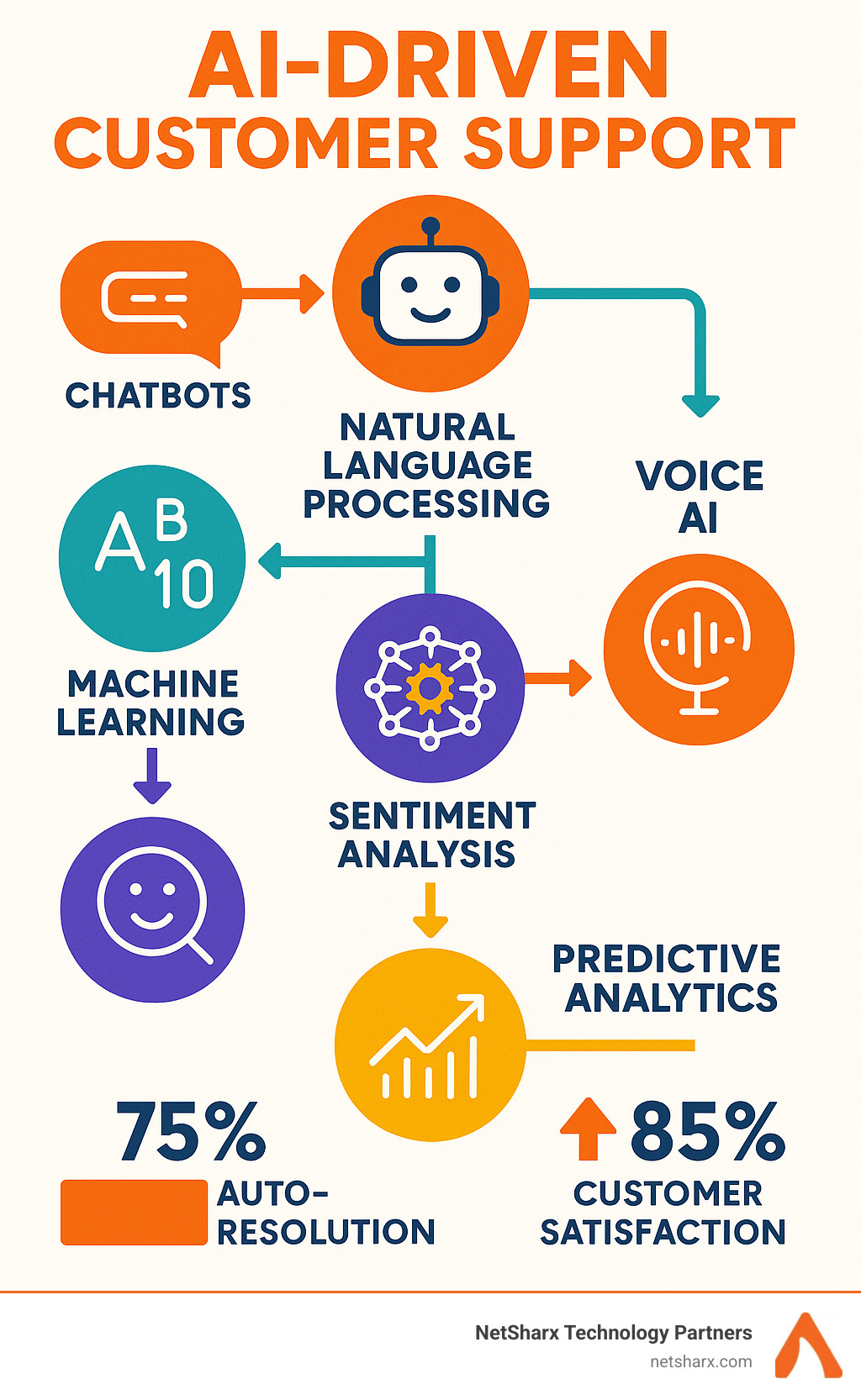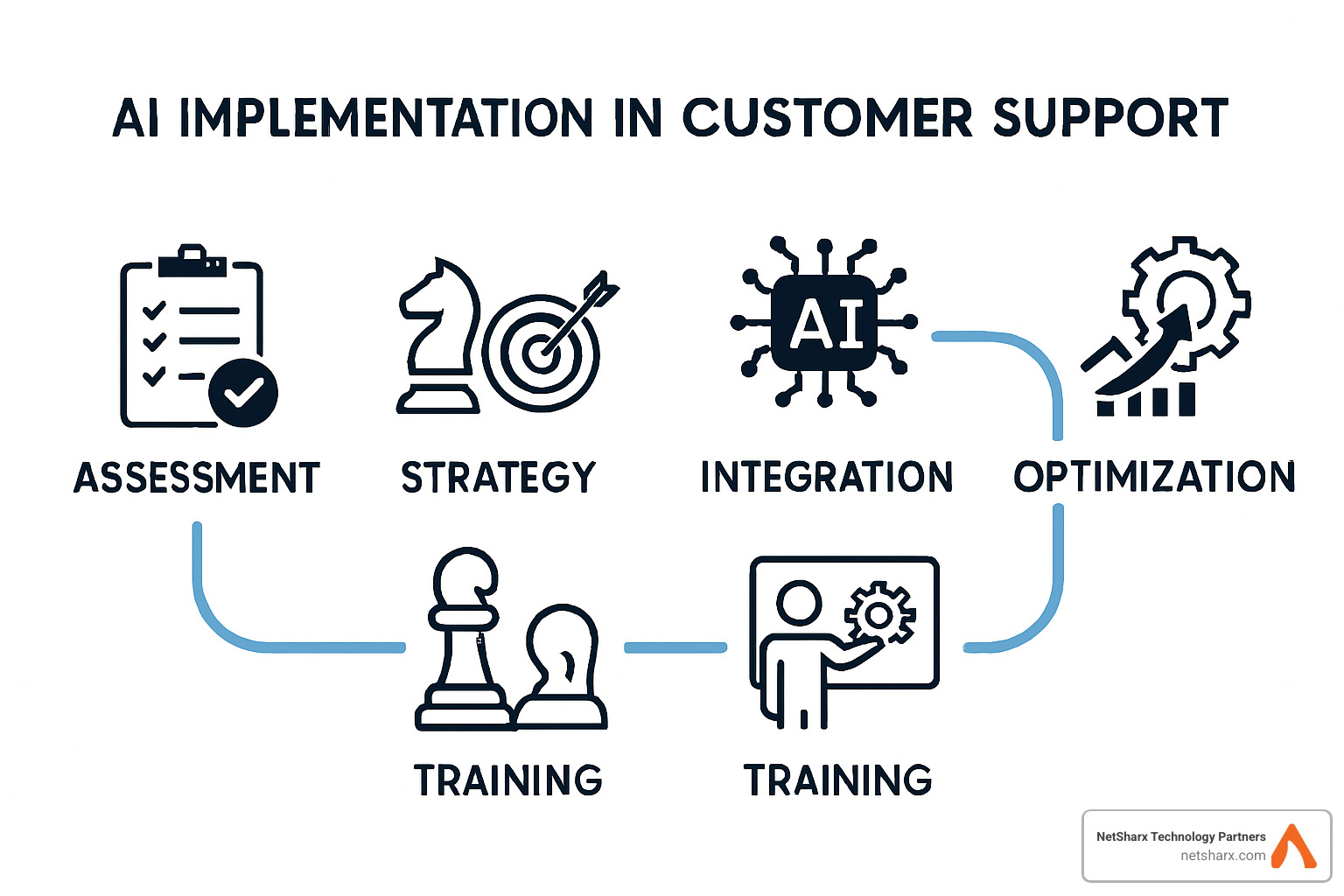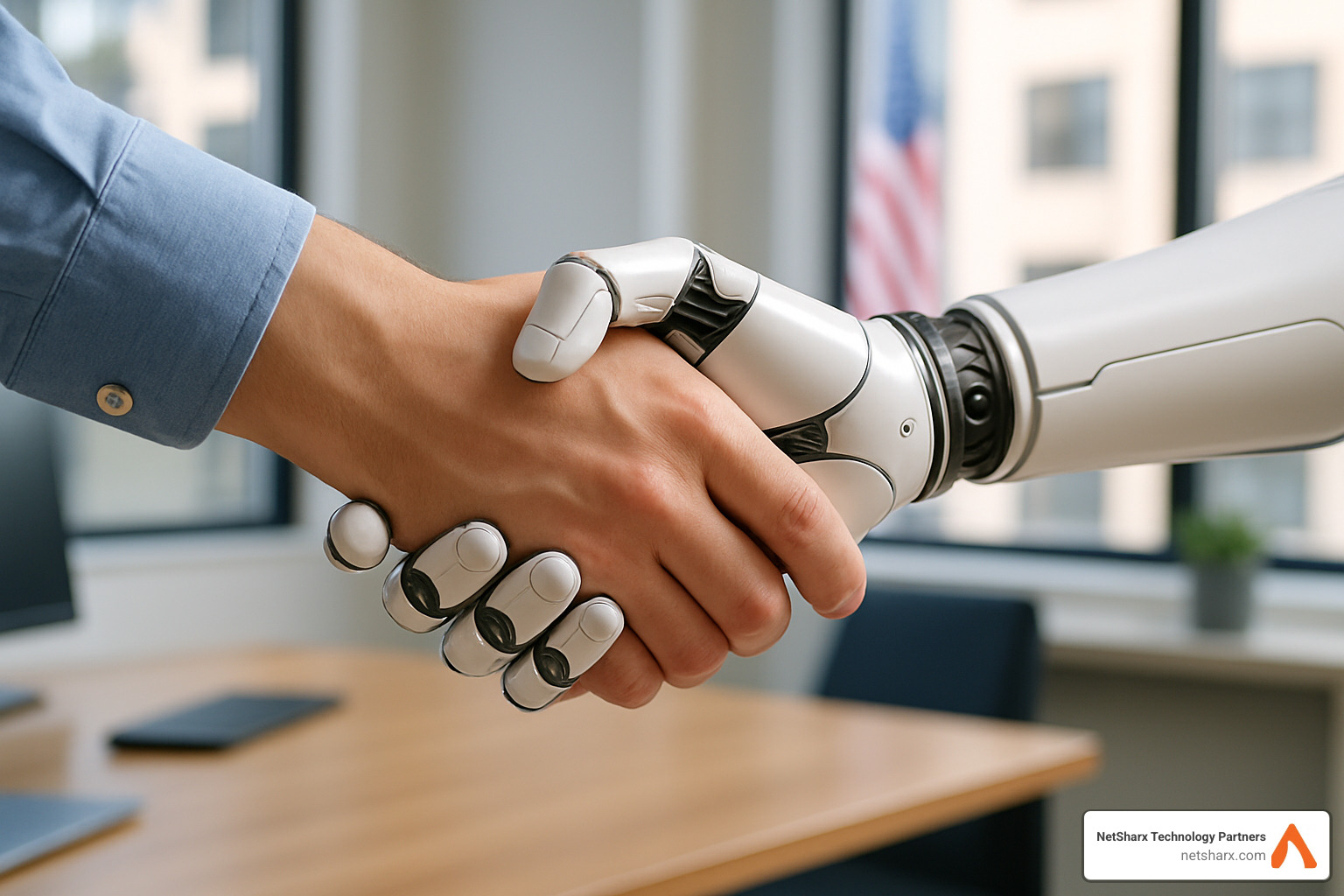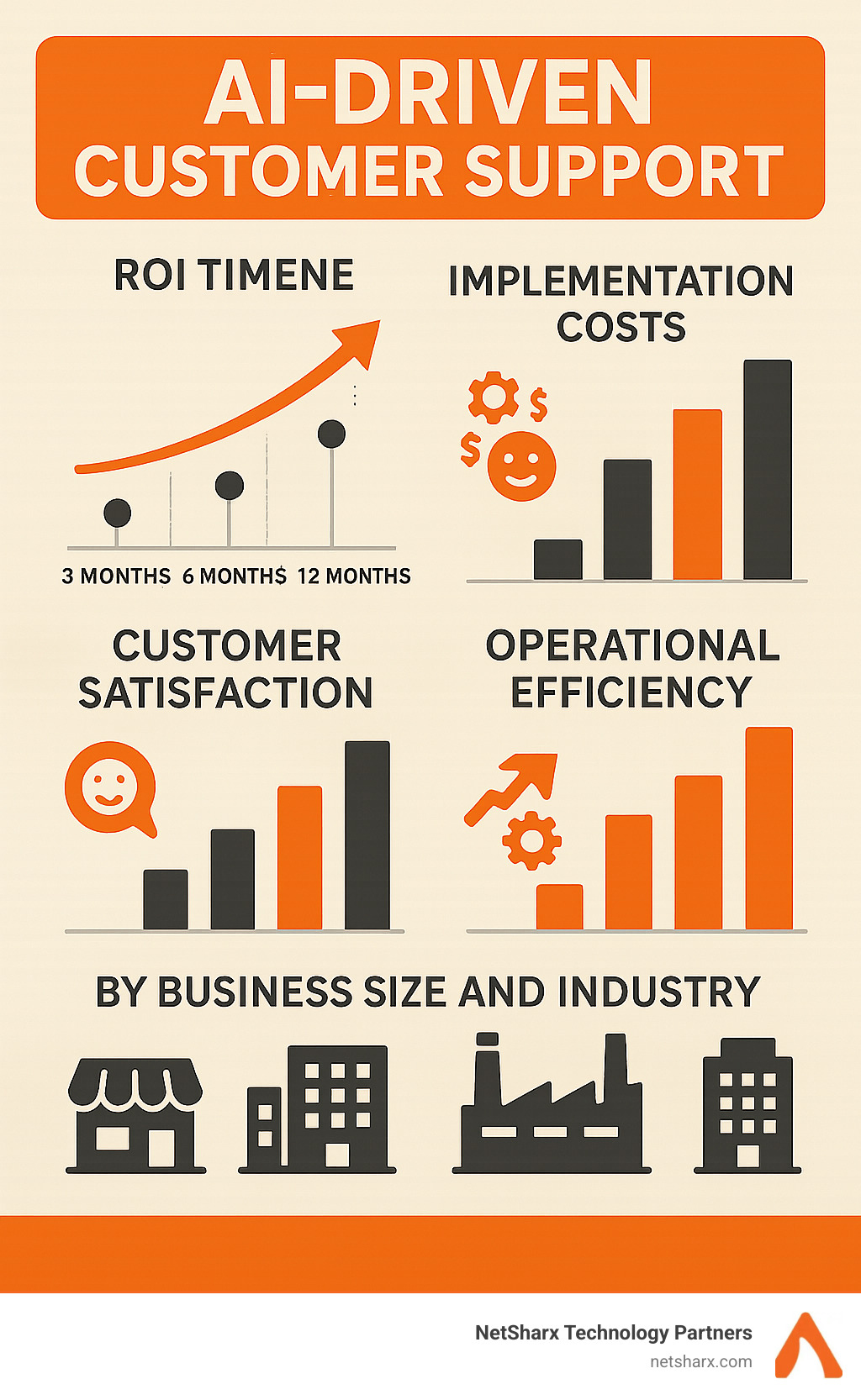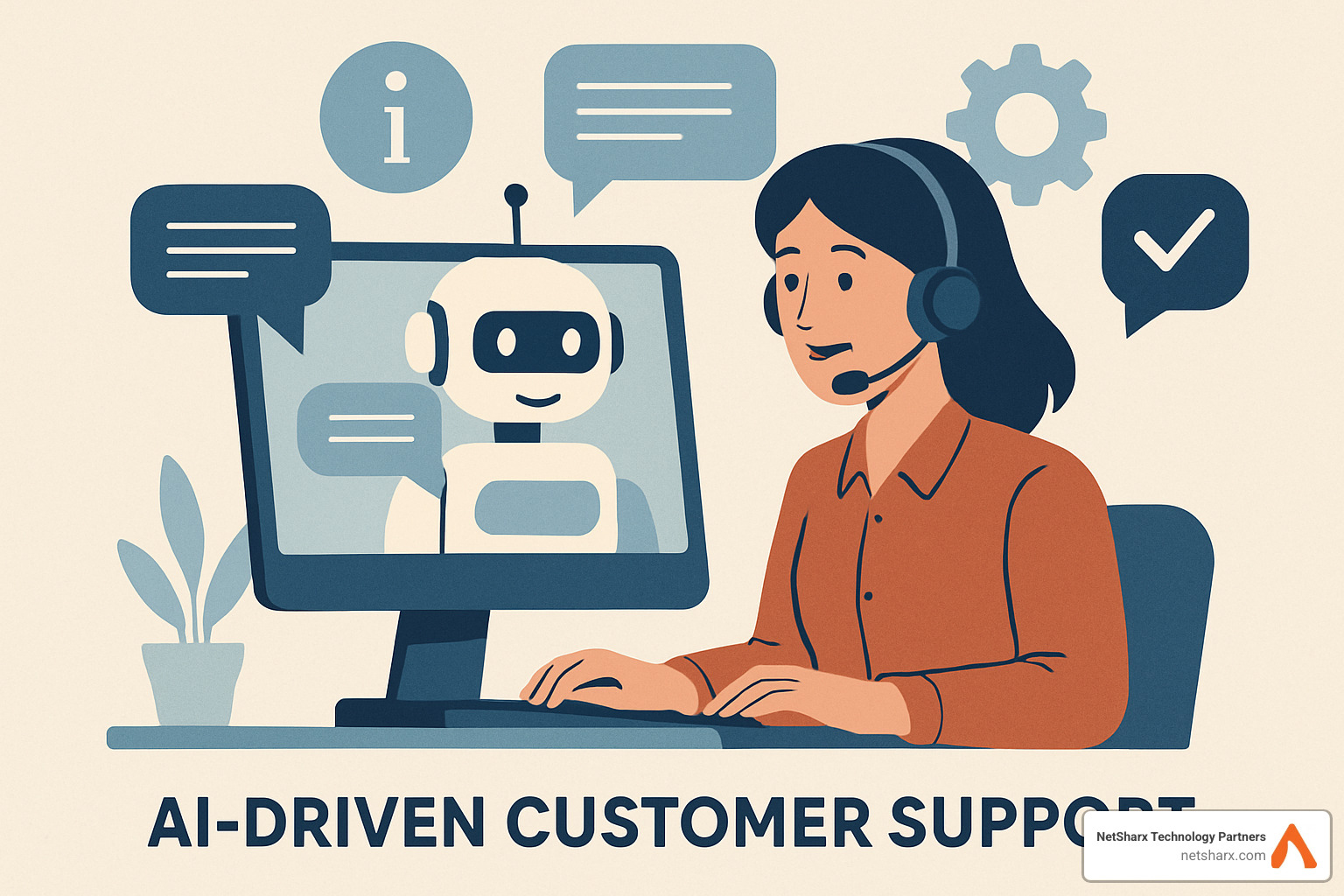AI-Driven Customer Support: 8 Powerful Benefits in 2025
Why AI-Driven Customer Support Is Reshaping Business Today
AI-driven customer support is changing how businesses interact with customers by using artificial intelligence technologies like chatbots, natural language processing, and machine learning to automate responses, personalize experiences, and provide 24/7 assistance.
Key Components of AI-Driven Customer Support:
– Chatbots & Virtual Assistants – Handle routine inquiries automatically
– Natural Language Processing – Understands customer intent and emotion
– Machine Learning – Improves responses over time through data analysis
– Sentiment Analysis – Detects customer mood to tailor interactions
– Voice AI – Processes phone calls without human intervention
– Predictive Analytics – Anticipates customer needs before they ask
The numbers tell the story. 80% of customers will switch to a competitor after more than one bad experience, while businesses using AI customer service see 75% auto-resolution rates and 85% improved customer satisfaction scores. Companies like Unity deflected 8,000 tickets and saved $1.3 million by deploying AI agents.
But here’s what’s really driving this shift: customer expectations have skyrocketed. 82% of service professionals say customer demands have increased, and 78% of customers feel service is rushed. Meanwhile, responding within one minute can boost conversion rates by 391%.
The challenge for mid-sized enterprises is clear – you need to deliver instant, personalized support without breaking the budget or overwhelming your existing team.
I’m Ryan Carter, founder and CEO of NetSharx Technology Partners, where I’ve helped dozens of organizations migrate from legacy systems to cloud-based solutions that reduce costs by 30% or more while improving customer experience KPIs. Through my work with AI-driven customer support implementations, I’ve seen how the right approach can transform your cost center into a revenue generator.
What Is AI-Driven Customer Support & How It Works
Imagine having a support team that never needs coffee breaks, remembers every customer conversation perfectly, and gets better at solving problems with each interaction. That’s essentially what AI-driven customer support brings to your business—a digital workforce that transforms how you help customers.
The magic happens when several smart technologies work together seamlessly. Machine learning acts like the brain of the operation, spotting patterns in thousands of customer conversations to predict what people need. Natural language processing makes AI actually understand human conversation—not just keywords, but context and meaning. When a frustrated customer types “This is ridiculous, where’s my order?”, the system recognizes frustration, urgency, and the emotional state behind the request.
Generative AI has been a game-changer for creating natural, helpful responses. Instead of robotic messages, modern AI crafts personalized replies that actually sound human. Gartner predicts that 80% of customer service organizations will apply generative AI technology to improve customer experiences.
Voice AI takes this intelligence to phone conversations, understanding spoken requests and emotional cues from tone of voice. Sentiment analysis reads between the lines of every interaction, detecting whether someone is happy, confused, or about to cancel their service.
The real power comes from knowledge bases improved with RAG (Retrieval-Augmented Generation) search. Instead of generic responses, your AI pulls specific information from your actual policies, product manuals, and company procedures.
Core Building Blocks
Behind the scenes, AI-driven customer support runs on sophisticated architecture. Algorithms form the decision-making core, determining how to route conversations and what responses to generate. Data pipelines continuously feed information back into the system for learning and improvement.
Integrations and APIs connect everything to your existing business systems—CRM, helpdesk, inventory management, billing platforms. This integration allows AI agents to access real customer data, order histories, and account information.
AI-Driven Customer Support Personalization Engines
Modern AI systems build detailed customer profiles that capture behavioral patterns—how customers prefer to communicate, when they typically reach out, and what types of issues they commonly face. The system maintains complete interaction history, providing context from previous conversations, purchases, and support requests.
Recommendation models use sophisticated algorithms to suggest relevant products or solutions based on customer behavior. Predictive analytics anticipate customer needs before problems arise, changing customer support from reactive problem-solving into relationship building.
8 Key Benefits for Customer Experience & Bottom Line
When I talk to business owners about AI-driven customer support, they usually want to know one thing: “What’s in it for me?” The answer is compelling when you look at both customer experience improvements and bottom-line impact.
The 24/7 availability benefit is obvious but transformative. AI systems work while your human team sleeps, handles weekend emergencies, and never calls in sick. Scalability really shines during crisis moments—AI systems can handle thousands of simultaneous conversations without breaking a sweat.
Cost reduction is where finance teams get excited. Gartner research shows conversational AI will lower contact center labor costs by $80 billion by 2026. We’ve helped clients reduce support costs by 43% while actually improving service quality.
Response speed directly impacts your revenue. When AI responds in seconds instead of minutes, customers stay engaged. Scientific research on chatbot convenience confirms faster responses lead to higher customer satisfaction and more completed transactions.
Personalization at scale is where AI really flexes its muscles. Every customer gets a custom experience based on their history, preferences, and current situation. Consistent quality eliminates the “agent lottery” problem—AI delivers the same high-quality experience every single time.
Agent productivity improves because your human team can focus on interesting, challenging work instead of repetitive tasks. Data-driven insights flow automatically from every interaction, revealing patterns you never noticed.
Real-World Wins
The numbers from actual implementations tell the real story. Unity deflected 8,000 tickets and saved $1.3 million by connecting their AI agent to their knowledge base. A telecommunications provider we worked with achieved 96% CSAT scores using AI-driven customer support—higher than their human-only baseline.
Enterprise implementations regularly see 75% auto-resolution rates and $5 million in cost savings. One beauty retailer created an AI-powered chatbot that streamlines support by providing personalized skincare advice and product recommendations.
How AI-Driven Customer Support Scales With Demand
Modern AI-driven customer support systems automatically scale up and down based on demand. During quiet periods, the system uses minimal resources. When customer inquiries spike 10x, the system instantly allocates more processing power. Peak season handling becomes stress-free with no panic hiring of temporary staff.
| Traditional Support | AI-Driven Support |
|---|---|
| Limited by staff availability | 24/7 availability |
| Response time varies by workload | Consistent sub-second responses |
| Scaling requires hiring/training | Instant elastic scaling |
| Quality varies by agent | Consistent quality standards |
| High labor costs | Predictable operational costs |
| Manual data analysis | Automated insights generation |
Implementation Blueprint & Best Practices
Implementing AI-driven customer support can feel overwhelming, but there’s a proven path that works. After guiding dozens of organizations through this change, I’ve learned that success comes down to taking measured steps and building on small wins.
Start with assessment. Spend your first two weeks understanding what you’re working with. Look at your current support tickets and identify patterns. What questions come up repeatedly? Which issues eat up the most agent time? These repetitive, straightforward inquiries are your golden opportunities for AI automation.
Launch a focused pilot in weeks three through eight. Pick one specific area—maybe order status checks or password resets—and prove the concept there. This focused approach lets you learn without disrupting your entire operation.
Prepare your training data during weeks four through six. Gather your best support interactions, clean up the data, and organize it properly. Your AI will learn from this information, so make sure you’re teaching it your best practices.
Build in human oversight from the start. Your AI should know when it’s out of its depth and gracefully hand off to human agents. Integrate with your existing CRM and support systems early in the process. The magic happens when AI can access real customer data and order histories.
Track KPIs religiously. Monitor resolution rates, response times, customer satisfaction scores, and cost per interaction. These numbers tell you what’s working and what needs adjustment.
Step-By-Step Guide
Identify pain points by diving deep into your support data. Look for long wait times on simple questions, repetitive inquiries that drain agent energy, and after-hours requests that pile up overnight.
Choose tools that play nicely with your existing systems. You want platforms with pre-trained customer service models, transparent pricing, and strong security features.
Integrate systematically by connecting your AI to your CRM for customer context, your knowledge base for accurate information, and your ticketing system for smooth escalations.
Train your team for their evolved roles. Your agents will handle more complex, interesting cases while AI tackles the routine stuff. Monitor closely in the early weeks and optimize continuously based on real performance data.
Scaling AI-Driven Customer Support Across Channels
Once your pilot proves successful, expanding AI-driven customer support across all customer touchpoints creates a seamless experience.
Web chat integration transforms your website into an interactive support hub. Voice IVR systems become conversational instead of robotic. Social media DMs require special attention because the language is informal and conversations are often public.
Email automation can categorize incoming messages and automatically handle simple requests. In-app support provides contextual help based on what users are actually doing. Multilingual support opens global markets by providing real-time translation.
The key to successful scaling is maintaining consistency across all channels while respecting the unique characteristics of each platform.
Challenges, Ethics & Future Outlook
While AI-driven customer support offers tremendous benefits, successful implementation requires addressing several critical challenges and ethical considerations.
Data Privacy and Security: AI systems require access to customer data to function effectively, but this creates significant privacy responsibilities. Ensure your AI platform complies with GDPR, CCPA, and other relevant regulations.
Bias Mitigation: AI systems can perpetuate or amplify biases present in their training data. The National Institute of Standards and Technology recommends diverse training datasets and regular auditing of AI decisions for unfair outcomes.
AI Hallucinations: Generative AI models are prone to “hallucinations”—fabricating answers when they lack sufficient information. Implement robust fact-checking mechanisms and clear boundaries on what AI can and cannot answer definitively.
Workforce Impact Considerations: While AI doesn’t replace human agents entirely, it does change their roles significantly. 63% of executives expect to have invested in generative AI use cases to serve agents directly. Plan for retraining programs that help existing staff transition to higher-value activities.
Maintaining the Human Touch: 81% of service professionals report that customer expectations for a personal touch are higher than ever. The challenge is using AI to improve rather than replace human empathy in customer interactions.
When Human Intervention Remains Essential
Despite advances in AI technology, certain situations still require human expertise:
- Complex Problem-Solving: Multi-faceted issues that require creative solutions or policy exceptions
- Emotional Support Situations: When customers are dealing with sensitive issues like financial hardship or bereavement
- Legal and Compliance Issues: Situations involving potential legal liability or regulatory compliance
- High-Value Customer Relationships: Strategic accounts and major business decisions
- Crisis Management: During service outages, product recalls, or other crisis situations
The Next Decade of AI-Driven Customer Support
The future of AI-driven customer support points toward even more sophisticated service models:
Predictive Self-Healing Systems will identify and resolve issues before customers even notice them. Autonomous AI Agents will handle end-to-end complex processes with minimal human oversight. Emotion AI will read facial expressions, voice patterns, and text sentiment to provide more empathetic responses.
Proactive Service Models will shift from reactive problem-solving to predictive need fulfillment, reaching out to customers with solutions before problems arise. Nearly 50% of CEOs feel increased customer expectations will accelerate the use of new technologies like generative AI.
Frequently Asked Questions & Conclusion
After helping dozens of organizations transform their customer service operations, I’ve noticed the same questions come up again and again. Let me address the most common concerns I hear from business leaders considering AI-driven customer support.
What is AI-Driven Customer Support?
Think of AI-driven customer support as giving your customer service team a brilliant assistant that never sleeps, never forgets anything, and gets smarter with every conversation. It’s not about replacing the human touch—it’s about making every interaction faster, more accurate, and more personalized.
At its heart, this technology combines conversational AI that can chat naturally with customers, machine learning that improves responses over time, and sentiment analysis that picks up on whether someone’s frustrated or happy. The system also uses knowledge management to pull accurate information from your company’s databases and predictive analytics to anticipate what customers need.
How Quickly Can Businesses See ROI?
Most of our clients start seeing measurable improvements within 4-12 weeks, though the exact timeline depends on how complex your current setup is and what you’re trying to achieve.
In the first month, you’ll notice immediate changes. Response times drop from minutes to seconds for common questions. Your phone lines aren’t constantly busy anymore because the AI handles routine inquiries around the clock.
By month three, the numbers really start to shine. We’ve seen 43% cost savings in on-demand industries, and customer satisfaction scores consistently improve. One telecommunications client achieved 96% customer satisfaction scores within three months of deployment.
The long-term value is where things get exciting. Enterprise clients report $5 million or more in cost savings and 75% auto-resolution rates for routine inquiries.
Will AI Replace Human Agents?
This is the question that keeps support managers up at night, and I understand why. But here’s what I’ve learned from dozens of implementations: AI doesn’t replace humans—it makes them superheroes.
The magic happens when AI handles the routine stuff—password resets, order status checks, basic troubleshooting—so your human agents can focus on what they do best. Complex problem-solving that requires creativity. Emotional support during difficult situations. Building relationships with your most important customers.
Your AI system quietly handles 65-80% of typical support volume in the background, while human agents tackle the cases that really matter. When a customer needs to escalate, they’re talking to a human agent who already has complete context from the AI interaction.
More than two-thirds of customer experience organizations report that AI actually helps them provide warmer, more personal service. The future isn’t about choosing between AI and humans—it’s about creating teams where both work together seamlessly.
At NetSharx Technology Partners, we’ve seen this change happen over and over. Companies worry they’ll lose the personal touch, but instead, they find they can finally deliver the kind of service they’ve always wanted to provide.
Ready to explore how AI-driven customer support could transform your customer experience while reducing costs? Learn more about our cloud and communications solutions and let’s discuss what’s possible for your organization.
Ready to Transform Your Customer Support?
The shift to AI-driven customer support represents more than just a technology upgrade—it’s your opportunity to completely reimagine how your business builds relationships with customers in a world where expectations keep rising and patience keeps shrinking.
The businesses that succeed aren’t just implementing AI tools. They’re creating support experiences that feel more human than ever before, where technology handles the routine stuff so your team can focus on what really matters—solving complex problems and building genuine connections.
Your customers don’t care whether they’re talking to AI or a human agent. They care about getting their problems solved quickly, accurately, and with respect. When AI handles password resets and order status checks in seconds, your human agents have time to help the customer dealing with a billing error that’s affecting their business operations.
The numbers speak for themselves. Companies implementing AI-driven customer support typically see 30% cost reductions within the first year, but more importantly, they see happier customers and more engaged support teams.
At NetSharx Technology Partners, we take a different approach to AI implementation. Instead of pushing a single vendor’s solution, we work with our extensive provider network to find the AI platform that actually fits your specific needs, budget, and timeline.
Our agnostic approach means we’ll tell you honestly whether you need a simple chatbot integration or a comprehensive AI overhaul. Sometimes the best solution is starting small with one specific use case and growing from there.
The change process doesn’t have to be overwhelming. We typically see measurable improvements within the first month, with full ROI realized in under six months. The key is having a partner who understands both the technology and your business objectives.
Ready to see what AI-driven customer support can do for your business? Explore our cloud and communications solutions to find how we can help you create support experiences that wow your customers while making your team’s lives easier.
The future of customer support isn’t about replacing human connection—it’s about using AI to make those human moments even more meaningful. Let’s build that future together.

